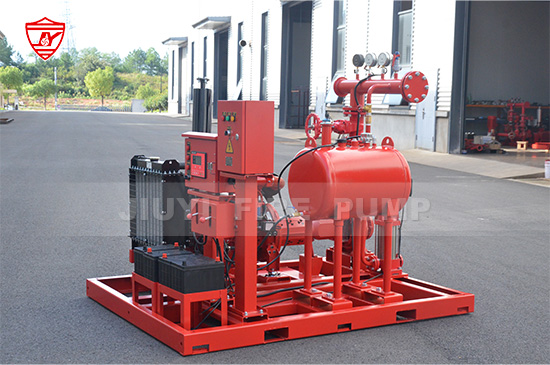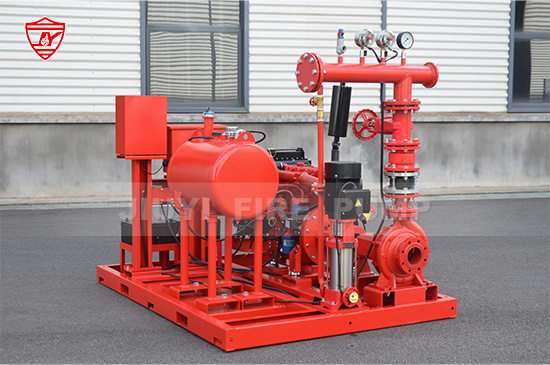Cavitation is one of the most common and damaging problems that affect fire pumps. Left unaddressed, it can severely reduce efficiency, damage impellers, and even lead to total pump failure. For fire protection systems, this is more than just a maintenance issue—it can mean the difference between a reliable emergency response and catastrophic downtime.
As a fire pump manufacturer, we often receive inquiries about why a pump is producing noise, vibration, or reduced flow—and in many of these cases, cavitation is the root cause. This article will explain what cavitation is, how to recognize its symptoms, identify its causes, and the best steps to troubleshoot and prevent it from recurring.

Cavitation occurs when the pressure in a liquid drops below its vapor pressure, forming vapor bubbles in the suction side of the pump. When these bubbles collapse violently inside the pump casing or on the impeller surface, they create shockwaves that cause pitting, erosion, and noise.
In fire pumps, cavitation can lead to:
Loss of pump capacity and pressure
Excessive vibration and noise
Damaged impeller or casing surfaces
Decreased system reliability and lifespan
Fire pumps—especially those operating under variable suction conditions—are particularly vulnerable if system design or operation does not maintain adequate Net Positive Suction Head (NPSH).
Identifying cavitation early is crucial for avoiding expensive repairs or downtime. Some of the most recognizable signs include:
Unusual Noise – A fire pump suffering from cavitation often produces a distinctive “gravel” or “marble” sound, caused by the implosion of vapor bubbles.
Vibration – Continuous vibration can indicate that the impeller is unbalanced or that bubbles are collapsing unevenly within the casing.
Reduced Flow or Pressure – If your system suddenly shows a drop in performance, cavitation may be restricting the effective pumping capacity.
Pitting or Damage on Impeller Blades – Inspecting the impeller after operation may reveal a rough or eroded surface, a typical cavitation result.
High Power Consumption – Cavitation can increase load and energy use, signaling reduced hydraulic efficiency.
Understanding why cavitation occurs is key to solving it effectively. Below are the most common causes found in firefighting systems:
The most frequent cause of cavitation is insufficient NPSH available compared to what the pump requires. This can happen if:
The suction tank level is too low.
Suction piping has excessive friction losses.
There are air leaks on the suction side.
The suction lift is higher than design limits.
Even a small leak can allow air to enter the suction line, leading to vapor bubble formation. Loose flanges, deteriorated gaskets, or improperly sealed fittings are often the culprits.
When the impeller rotates too fast, the velocity at the impeller eye increases, reducing pressure and promoting cavitation. Incorrect motor or engine speed settings can be to blame.
Long, narrow, or sharply bent suction pipes can create turbulence and reduce NPSH. Suction piping should always be short, straight, and large enough to ensure smooth flow.
Hot water has a lower vapor pressure, which makes it easier for bubbles to form. Fire pumps drawing from tanks exposed to sunlight or heat sources can face this issue.
Obstructions, debris, or throttled valves restrict flow, causing pressure drop and localized vaporization near the impeller.
Troubleshooting cavitation requires a systematic approach to identify and eliminate the underlying cause rather than just addressing the symptom. Here’s a practical guide fire pump technicians and operators can follow:
Start by noting any abnormal noise, vibration, pressure fluctuation, or drop in flow rate. Compare performance with baseline readings from pump commissioning or NFPA 25 inspection data.
Verify that the suction tank or water source maintains the required level.
Inspect suction strainers or filters for clogging.
Confirm that all suction valves are fully open.
Examine the suction pipe for leaks, corrosion, or air ingress points.
Calculate both NPSH available (from the system) and NPSH required (from the pump curve). Ensure that the available NPSH exceeds the required margin by a comfortable safety factor—typically 0.6–1.0 meters above minimum requirement for fire pumps.
After shutdown and depressurization, open the pump casing to inspect the impeller. Look for:
Erosion or pitting near the eye or leading edges.
Deposits or blockages reducing flow area.
Any imbalance caused by uneven wear.
Ensure that the driver (electric motor or diesel engine) operates at the rated speed. Over-speeding can easily trigger cavitation. Misalignment may also cause vibration, worsening the damage.
Ensure suction piping is as short and straight as possible.
Use long-radius elbows if direction changes are unavoidable.
Avoid high points in suction lines where air can accumulate.
Check that the suction pipe diameter is at least equal to or larger than the pump’s suction flange.
If the water temperature is unusually high, take measures to reduce it—such as insulating tanks or providing shaded storage. Fire pumps should never operate with fluid temperatures exceeding design limits.
Prevention is always more cost-effective than repair. The following practices help maintain optimal performance and longevity of fire pumps:
Proper System Design
Ensure sufficient NPSH margin during system design and installation. Follow NFPA 20 guidelines for suction piping layout, including straight pipe length and valve type requirements.
Regular Maintenance and Inspection
Routine inspection of suction valves, strainers, seals, and joints helps detect potential air leaks or obstructions before they cause issues.
Monitor Water Levels
Keep an eye on the water source. Low tank levels can reduce suction head, especially in gravity-fed or static suction systems.
Record Operating Data
Maintain logs for flow rate, discharge pressure, suction pressure, and vibration levels. Changes in performance patterns can alert operators to early cavitation signs.
Use Correct Pump Speed
Always ensure the driver speed matches the rated pump curve speed. If a diesel engine is used, verify governor calibration.
Choose the Right Pump Type
For deep wells or fluctuating suction levels, vertical turbine fire pumps may be a better choice than end suction types. They are designed to handle variable suction conditions more efficiently.
Cavitation does not only damage equipment—it can compromise the entire fire protection system’s readiness. Reduced flow or pressure during an emergency could lead to system failure, risking property loss or even lives.
For facilities that rely on fire pumps—whether industrial plants, data centers, high-rise buildings, or warehouses—maintaining optimal pump performance is critical. Troubleshooting cavitation promptly ensures your fire pump delivers reliable pressure when it matters most.

Cavitation in fire pumps is a serious yet preventable issue. By understanding the warning signs, analyzing suction conditions, and following best practices in design and maintenance, you can significantly reduce the risk of damage and downtime.
Fire pumps are the heart of a fire protection system. Keeping them free from cavitation ensures consistent performance, long service life, and compliance with NFPA 20 standards. Regular inspection, proper operation, and attention to system details are your best defense against this silent threat.